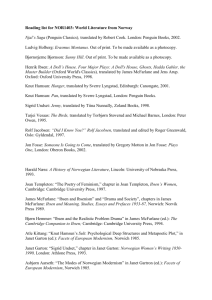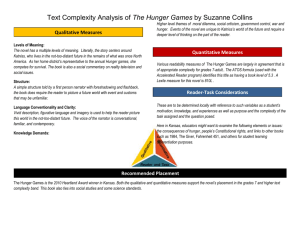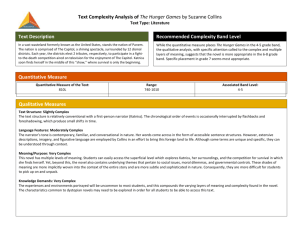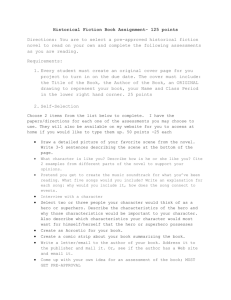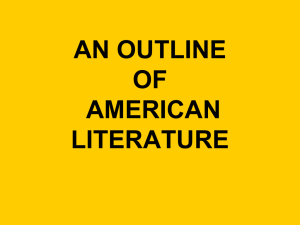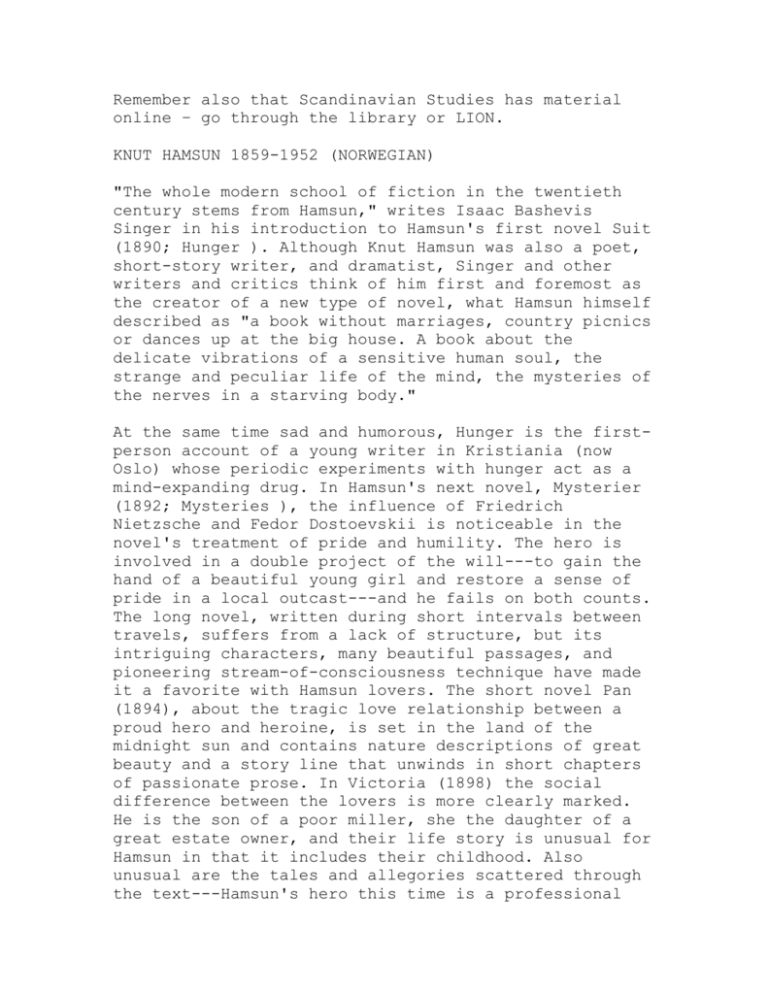
Remember also that Scandinavian Studies has material
online – go through the library or LION.
KNUT HAMSUN 1859-1952 (NORWEGIAN)
"The whole modern school of fiction in the twentieth
century stems from Hamsun," writes Isaac Bashevis
Singer in his introduction to Hamsun's first novel Suit
(1890; Hunger ). Although Knut Hamsun was also a poet,
short-story writer, and dramatist, Singer and other
writers and critics think of him first and foremost as
the creator of a new type of novel, what Hamsun himself
described as "a book without marriages, country picnics
or dances up at the big house. A book about the
delicate vibrations of a sensitive human soul, the
strange and peculiar life of the mind, the mysteries of
the nerves in a starving body."
At the same time sad and humorous, Hunger is the firstperson account of a young writer in Kristiania (now
Oslo) whose periodic experiments with hunger act as a
mind-expanding drug. In Hamsun's next novel, Mysterier
(1892; Mysteries ), the influence of Friedrich
Nietzsche and Fedor Dostoevskii is noticeable in the
novel's treatment of pride and humility. The hero is
involved in a double project of the will---to gain the
hand of a beautiful young girl and restore a sense of
pride in a local outcast---and he fails on both counts.
The long novel, written during short intervals between
travels, suffers from a lack of structure, but its
intriguing characters, many beautiful passages, and
pioneering stream-of-consciousness technique have made
it a favorite with Hamsun lovers. The short novel Pan
(1894), about the tragic love relationship between a
proud hero and heroine, is set in the land of the
midnight sun and contains nature descriptions of great
beauty and a story line that unwinds in short chapters
of passionate prose. In Victoria (1898) the social
difference between the lovers is more clearly marked.
He is the son of a poor miller, she the daughter of a
great estate owner, and their life story is unusual for
Hamsun in that it includes their childhood. Also
unusual are the tales and allegories scattered through
the text---Hamsun's hero this time is a professional
poet. Less striking than Pan, Victoria has sweetness
and charm, and Arthur Koestler has called it "one of
the great love stories in World Literature."
Although it is generally agreed that Hamsun's novels
from the 1890s are his greatest, Hamsun wrote 15 more
novels during the next 40 years, many of them
masterworks. In some, the love story is less important
than the social setting. In Konerne ved vandposten
(1920; The Women at the Pump ) Hamsun writes with humor
and irony about the transformation of country
communities into urban areas: "Ah, that little ant
hill! Everyone busy with his own affairs, crossing each
other's path, elbowing each other aside, sometimes even
trampling on each other. That's the way it is,
sometimes they even trample on each other ... " . Best
known of these novels from the middle period is Markens
grode (1917; The Growth of the Soil ), about an
anonymous character, Isak, who wanders into the
wilderness to clear new land for himself and his
family. H.G. Wells' enthusiasm for the book--- "It
impresses me as among the very greatest novels I have
ever read. It is wholly beautiful; it is saturated with
wisdom and humour and tenderness" ---may be a reaction
against the senselessness of World War I. Hamsun's
back-to-nature program also impressed the Swedish
Academy, which awarded him the Nobel prize for
literature in 1920.
Deeply disillusioned over World War I and its outcome,
Hamsun wrote two of his most pessimistic novels in the
early 1920s. Then, after undergoing psychoanalytic
treatment, he regained his writing ability and some of
the humor of his first social novels. The trilogy about
the good companions Edevart and August (1927-33)
contains many elements of his earlier work---the tragic
love story and the back-to-nature message, for example--but it is first and foremost a novel about 20thcentury emigration and general rootlessness. The first
volume in the trilogy, Landstrykere (1927; Wayfarers ),
is Hamsun's longest novel and one of his best. Hamsun's
last novel, Ringen sluttet (1936; The Ring Is Closed ),
is the first part of a book that was never completed,
but even as a torso it is one of his great works. The
hero, Abel Brodersen, is a hippie long before the time
of hippies. A sailor who has lived in a commune in
Kentucky, Brodersen returns to the home of his
childhood, disillusioned, but totally without social
ambition and, in that limited sense, a free man. A
stoic, like many of the author's earlier heroes, Abel
Brodersen is more than any other Hamsun protagonist a
man of our own time.
During World War II, Hamsun sided with Germany and
wrote articles defending its actions in occupied
Norway. When the war was over he was arrested and was
found by a psychiatrist to suffer from "permanently
reduced mental faculties." Hamsun was tried and found
guilty and sentenced to surrender everything he owned
to the state of Norway. Despite his advanced age,
Hamsun was able to include these and many other
experiences into a charming and moving memoir, På
gjengrodde stier (1949; On Overgrown Paths ), published
after his 90th birthday.
Hamsun was above all an aesthete, a stylist, a writer
more concerned with his medium than with his message.
Typical of his style is a strong reliance on rhythm and
repetition, which he employed until the end of his
days, even though his lyricism gradually gave way to a
more epic manner of presentation. Strangely, Hamsun's
lifelong theme of alienation is always accompanied by a
message of joy. Henry Miller responded to that message
when he wrote, "It was from ... Knut Hamsun that I
derived much of my love of life, love of nature, love
of men."
Harald S. Naess
See also HUNGER BY KNUT HAMSUN (SULT 1890)
Biography
return to top
Born Knut Pedersen in Lom, Norway, 4 August 1859.
Apprenticed to a shoemaker in Bodö, then a road worker;
lived in the United States, 1882-84, 1886-88; streetcar
conductor in Chicago, farm worker in North Dakota, and
secretary and lecturer in Minneapolis; lived in Paris
for several years, early 1890s; traveled in Finland,
Russia, and Denmark during the 1890s and 1900s; writer
after 1890, and farmer after 1911. Openly supported
Quisling's pro-German party during World War II;
arrested, tried and found guilty, and ordered to
surrender all his belongings to the state of Norway
after the war (also briefly confined to a mental
institution). Awarded Nobel prize for literature, 1920.
Died 19 February 1952.
Selected Novels by Hamsun
return to top
Sult , 1890; as Hunger , translated by George Egerton,
1899; also translated by Robert Bly, 1967, and by
Sverre Lyngstad, 1996
Mysterier , 1892; as Mysteries , translated by Arthur
G. Chater, 1927; also translated by Gerry Bothmer, 1971
Pan , 1894; as Pan , translated by W. W. Worster, 1920;
also translated by James McFarlane, 1955
Victoria , 1898; as Victoria , translated by Arthur G.
Chater, 1923; as Victoria: A Love Story , translated by
Oliver Stallybrass, 1969
Under hoststjoernen , 1906; as Autumn , translated by
W. W. Worster, in Wanderers , 1922; as Under the Autumn
Star , translated by Oliver and Gunnvor Stallybrass, in
The Wanderer , 1975
En vandrer spiller med sordin , 1909; as With Muted
Strings , translated by W.W. Worster, in Wanderers ,
1922; as A Wanderer Plays on Mute Strings , translated
by Worster, 1922; as On Muted Strings , translated by
Oliver and Gunnvor Stallybrass, in The Wanderer , 1975
Segelfoss by , 1915; as Segelfoss Town , translated by
J.S. Scott, 1925
Markens grode , 1917; as The Growth of the Soil ,
translated by W.W. Worster, 1920
Konerne ved vandposten , 1920; as The Women at the Pump
, translated by Arthur G. Chater, 1928; also translated
by Oliver and Gunnvor Stallybrass, 1978
Landstrykere , 1927; as Vagabonds , translated by
Eugene Gay-Tifft, 1930; as Wayfarers , translated by
James W. McFarlane, 1980
August , 1930; as August , translated by Eugene GayTifft, 1931
Ringen sluttet , 1936; as The Ring Is Closed ,
translated by Eugene Gay-Tifft, 1937
Other Writings:
return to top
plays, short stories, poetry, travel writing, essays,
autobiography, and letters.
Further Reading
return to top
Baumgartner, Walter, Knut Hamsun , Reinbek bei Hamburg:
Rowohlt, 1997
Ferguson, Robert, Enigma: The Life of Knut Hamsun , New
York: Farrar, Straus and Giroux, and London:
Hutchinson, 1987
Hansen, Thorkild, Prosessen mot Hamsun , Oslo:
Gyldendal, 1978
Kittang, Atle, Luft, Vind, Ingenting: Hamsuns
desillusjonsromanar frå "Sult" til "Ringen sluttet ,"
Oslo: Gyldendal, 1984; 2nd edition, 1996
McFarlane, James W., "The Whisper of the Blood: A Study
of Knut Hamsun's Early Novels," PMLA 71 (1956)
Naess, Harald S., Knut Hamsun , Boston: Twayne, 1984
Nettum, Rolf Nyboe, Konflikt og visjon: Hovedtemaer i
Knut Hamsuns forfatterskap 1890-1912, Oslo: Gyldendal,
1970
Nilson, Sten Sparre, En orn i uvoer , Oslo: Gyldendal,
1960
Ostby, Arvid, Knut Hamsun (bibliography), Oslo:
Gyldendal, 1972
Popperwell, Ronald, "Critical Attitudes to Knut Hamsun,
1890-1969" (bibliography), Scandinavica 9 (1970)
View Select Bibliography for the Encyclopedia of the
Novel
View List of Contributors for the Encyclopedia of the
Novel
This mail has been sent by Graeme Macdonald.
Found in Literature Online, the home of literature and
criticism. Copyright © 1996-2009 ProQuest LLC. All
Rights Reserved.
http://lion.chadwyck.co.uk.
Article Text:
HUNGER BY KNUT HAMSUN (SULT 1890)
[SULT]
In The Western Canon (1994), Harold Bloom offers a
provoking definition of the great novel as that which
bears an uncanny relation to tradition: "When you read
a canonical work for a first time you encounter a
stranger, an uncanny startlement rather than a
fulfillment of expectations." Just such a stranger,
Knut Hamsun's first novel is arguably also the first
modern novel in the Western canon. Hunger is a firstperson narrative that recounts the mostly dire
experiences of an anonymous young man trying (and just
as often not trying) to make a living from writing,
while having (or choosing) to go without food or fixed
address, in the city of Kristiania. A mixture of
ecstatic, traumatic, and delirious events concludes
with the narrator leaving town on a ship bound for
England. Hamsun's book resembles other 19th-century
works of fiction, and yet it startles and eludes every
conventional generic classification. One of his more
recent biographers, Harald Naess, cites a letter in
which Hamsun states simply, "My book is not to be
looked upon as a novel" (see Naess, 1984). Perhaps such
a claim can be made of any great novel, but Hunger is
nevertheless a remarkable instance of historical
originality and elusiveness.
A reliable English translation has become available
only very recently. Sverre Lyngstad's 1996 translation
of the original Norwegian is in innumerable respects
more accurate and complete than that of either Mary
Dunne (alias George Egerton) in 1899 or Robert Bly in
1967. It may be that this new translation will help to
bring Hunger to a wider audience. In the foreword to
Lyngstad's new translation, Duncan McLean likens the
novel to Irvine Welsh's Trainspotting (1993) and other
innovative contemporary fiction, a parallel that is at
once insightful and misleading. No doubt the uncanny
elusiveness of the novel does reside partly in its
peculiar resonances with current writing: it is
difficult, for example, to read the work of Paul Auster
without a recurrent awareness of the lurking presence
of Hunger , and indeed Auster's 1970 essay on Hamsun's
novel remains one of the best critical accounts in
recent years. But Hunger is also a text that locates
itself very specifically in late 19th-century Oslo (or
Kristiania, as it was then called) and that "belongs"
to its time both in sociocultural and literary
historical terms.
Some of its literary and philosophical precursors can
be readily, if inadequately, named: Poe (for
perversity), Dostoevskii (for narrative delirium),
Twain (for frivolity), Nietzsche and Strindberg (for
fragmented and multiple identity). But the originality
of Hamsun's work can perhaps best be understood in two
ways. First, it is a novel in which narrative time
itself disintegrates. As John Vernon puts it: "a pure
narrative present, a sense of time continuously
billowing and literally getting nowhere, for the first
time fully occupies fiction" (see Vernon, 1984).
Second, it is a novel explicitly concerned with writing
and the desire or need to fail. As Auster points out:
"it would be wrong to dismiss the hero of Hunger as a
fool or a madman. In spite of the evidence, he knows
what he is doing. He does not want to succeed. He wants
to fail. Something new is happening here, some new
thought about the nature of art is being proposed in
Hunger " (see Auster, 1990). In its elaboration of the
links between writing and failure, between writing,
hunger (in various forms), and self-annihilation,
Hamsun's novel seems uncannily to "project" the
writings and voices of Franz Kafka, Maurice Blanchot,
Georges Bataille, and Samuel Beckett. One may hear the
tragicomic tonalities of Beckett, for example, in "I
sat down once more on a bench near the Church of Our
Saviour and dozed with my head on my breast, limp after
my last excitement, sick and worn-out with hunger. Time
passed. ... I had picked up a little stone, which I
brushed off and stuck in my mouth to have something to
munch on. Otherwise I didn't stir, didn't even move my
eyes. People came and went." Or one may hear the
strangeness of the narrative voice of Blanchot's "The
Madness of the Day," in such an exchange as the
following:
I began ... running my head against the lampposts on
purpose ... and biting my tongue in frenzy when it
didn't speak clearly, and I laughed madly whenever it
fairly hurt.
"Yes, but what shall I do?" I asked myself at last. I
stamp my feet on the pavement several times and repeat,
"What shall I do?" A gentleman just walking by remarks
with a smile, "You should go and ask to be locked up."
What this last passage also brings out---and the
Lyngstad translation does this with a precision and
consistency lacking in earlier translations---are the
eerie temporal dislocations generated by the novel's
delirious shifting between past and present tenses ("I
asked," "I stamp," and so on). Such shifts testify to
the singular writtenness of this text about the aporias
and impossibilities of satisfying the intoxicating,
deathly hunger of writing itself.
Nicholas Royle
See also KNUT HAMSUN 1859-1952 (NORWEGIAN)
Further Reading
return to top
Auster, Paul, "The Art of Hunger," in Ground Work:
Selected Poems and Essays 1970-1979, London: Faber,
1990
Buttry, Dolores, "The Passive Personality: Hamsun's
Hamlets," Symposium 36:2 (1982)
Ellmann, Maud, The Hunger Artists: Starving, Writing
and Imprisonment , London: Virago, and Cambridge,
Massachusetts: Harvard University Press, 1993
Ferguson, Robert, Enigma: The Life of Knut Hamsun , New
York: Farrar, Straus and Giroux, and London:
Hutchinson, 1987
McFarlane, James W., "The Whisper of the Blood: A Study
of Knut Hamsun's Early Novels," PMLA 71 (1956)
Naess, Harald S., Knut Hamsun , Boston: Twayne, 1984
Riechel, Donald C., "Knut Hamsun's 'Imp of the
Perverse': Calculation and Contradiction in Sult and
Mysterier ," Scandinavica: International Journal of
Scandinavian Studies 28:1 (1989)
Vernon, John, Money and Fiction: Literary Realism in
the Nineteenth and Early Twentieth Centuries , Ithaca,
New York: Cornell University Press, 1984; London:
Cornell University Press, 1985
View Select Bibliography for the Encyclopedia of the
Novel
View List of Contributors for the Encyclopedia of the
Novel
This mail has been sent by Graeme Macdonald.
Found in Literature Online, the home of literature and
criticism. Copyright © 1996-2009 ProQuest LLC. All
Rights Reserved.
http://lion.chadwyck.co.uk.
Article Text:
Hamsun, Knut (1859-1952)
Norwegian novelist, dramatist and poet, was born in
Lom, Gudbrandsdalen. He is the major prose writer of
Norwegian literature and after Henrik Ibsen, its most
widely known literature figure. Hamsun grew up in
Nordland county, and its landscape and social structure
are mirrored in most of his work. As a young man he
spent several years in the United States, working at
odd jobs, as a streetcar conductor in Chicago, farmhand
in North Dakota, and secretary and public lecturer in
Minneapolis. The stay had a profound influence on his
political views and literary style. Its immediate
result was Fra det moderne Amerikas Aandsliv (1889;
Eng. tr., The Spiritual Life of Modern America, 1969),
a sarcastic depiction of what he considered America's
spiritual poverty. He later, in an article in 1928,
modified his views and expressed his indebtedness to
American optimism and work ethic. After years of
bohemian existence, Hamsun married for the second time
in 1909 and settled down as a farmer-writer, first in
Nordland, and later (1917) at Norholm near Grimstad,
where he lived until his death. Around the turn of the
century, Hamsun published an important volume of poetry
Det vilde Kor (1904; The Chorus) and several plays that
enjoyed considerable popularity, particularly in
Russia. He is now chiefly remembered, however, as the
author of a dozen significant novels that fall into
three major categories: the romantic works of the
1890s, the social novels from the World War I period,
and the Vagabond trilogy from the years 1927-33.
Hamsun's early romantic works include his greatest
novels: Sult (1890; Eng. tr., Hunger, 1899), Mysterier
(1892; Eng. tr., Mysteries, 1927), Pan (1894; Eng. tr.,
1920), and Victoria (1898; Eng. tr., 1929). Hunger --partly based on Hamsun's own experiences during several
unhappy stays in Norway's capital city---describes a
few fall and winter months in the life of an
impoverished young writer trying to survive in
Christiania (now Oslo). Forced and prolonged neglect of
his body gradually affects his mind to a point where he
can no longer collect his thoughts, and he seeks his
escape, not in death---the Hamsun hero's usual way out--but as a deckhand on a small ship bound for England.
Throughout the novel, hunger affects the hero's
temperament like a mind-expanding drug: against starkly
realistic surroundings, Hunger juxtaposes colorful
fantasies and humorous scenes that are unparalleled in
Hamsun's production. Some critics consider this first
novel his most powerful work.
The hero of Hunger sometimes experiences a splitting of
his personality, a motif that Hamsun developed further
in other works. In Mysteries, the protagonist appears
as two separate characters: the charlatan hero Nagel,
and the Midget, his alter ego in whom he sees his own
exhibitionism mercilessly caricatured. The two watch
each other suspiciously, like the antagonists of a
detective story. In Pan, written during three restless
years in Paris, Hamsun expressed his yearning for the
peace and natural beauty of Nordland, his childhood
county. This short novel, written in the form of a
hunter's diary, contains the most exquisite
descriptions of nature in Norwegian literature.
Victoria is Hamsun's sweetest love story. It includes
charming pictures of the lovers, Victoria and Johannes,
as innocent children, as well as a sentimental ending
involving Victoria's fatal tuberculosis and her final
confession of undying love.
In spite of their individual differences, however,
Hunger, Mysteries, Pan, and Victoria all feature a
Byronic hero, a tragic love story, and an emphasis on
what Hamsun, in an important early essay "Fra det
ubevidste sjæleliv" (1890; "From the Unconscious Life
of the Mind"), referred to as "the whisper of the
blood." Rather than employing the typical characters
and utilitarian philosophy of novels from the
naturalistic period ( see Norwegian literature), he
wished to illustrate the strange psychology of
exceptional people. During this stage of his career,
Hamsun's work recalls the art and outlook of Fyodor
Dostoyevsky and Friedrich Nietzsche. The influence of
the former is reflected in his heroes' fluctuations
between towering arrogance and deep humility, the
latter in Nagel's view of woman and supermen, as well
as in the Apollonian-Dionysian conflict of a character
such as Lieutenant Glahn in Pan. At the same time,
however, one can see, particularly in a more realistic
early novel like Ny Jord (1893; Eng. tr., Shallow Soil,
1914), a certain impatience with the youthful Byronic
hero.
After a transitional stage in which he wrote poetry,
plays, and a couple of lyrical first-person novels,
Under hoststjernen (1906) and En vandrer spiller med
sordin (1908; both novels published together in Eng.
tr., as Wanderers, 1922), Hamsun turned to large-scale
social novels in which the old artist-hero is reduced
to a secondary character, whose comments often reflect
Hamsun's opinions. These novels include Born av tiden
(1913; Eng. tr., Children of the Age, 1924) and
Segelfoss by (1915; Eng. tr., Segelfoss Town, 1925),
humorously ironic descriptions of the decline and fall
of a small Norwegian community, and Hamsun's poetic
eulogy of the practical farmer, Markens grode (1917;
Eng. tr., Growth of the Soil, 1921). For Markens grode,
Hamsun's most monumental, best-known work, he was
awarded the Nobel Prize for Literature in 1920. Yet
critics who welcomed the optimistic note in this novel
were soon disappointed. Hamsun's next two novels are
misanthropic, reflecting the author's disillusionment
with the outcome of World War I. Then, after a severe
crisis followed by psychoanalytic treatment (the first
of its kind in Norway), Hamsun produced the three
lively novels Landstrykere (1927; Eng. tr., Vagabond,
1930), August (1930; Eng. tr., 1931), and Men livet
lever (1933; Eng. tr., The Road Leads On, 1934), in
whom the old artist-protagonist reemerges on a
deromanticized level as August, a slightly ridiculous,
but very human, charlatan.
In later years, Hamsun's romanticism led him astray
politically. His apprentice years in the United States
(1882-84, 1886-88) had robbed him of his belief in
democracy as a power for advancing the cultural and
moral ennoblement of man. Furthermore, his early heroes
all reject scientific progress and industrialization
and recommend a return to nature and to the values of
the old aristocratic society. Hamsun, however, seeing
the preservation of a feudal system as anachronistic,
slowly came to accept the rugged individualist farmer
as his new hero. This trend, coupled with an old
admiration of Germany (and an equally old dislike of
the English), finally led Hamsun into the camp of the
Norwegian Nazis, whom he supported during the German
occupation of Norway in 1940-45. During the post-World
War II period, that mistake cost him his considerable
fortune and, for a number of years, his popularity as a
writer. In the two decades following his death in 1952,
however, the reissue of his collected works, the
publication of his moving memoirs of political
imprisonment, På gjengrodde stier (1949; Eng. tr., On
Overgrown Paths, 1967), and the appearance of
biographies by his wife and son gradually regained for
Hamsun his old position as Norway's most widely read
novelist.
See: H. A. Larsen, Knut Hamsun (1922);
J. W. McFarlane, "The Whisper of the Blood," PMLA
Publications of the Modern Language Association of
America 71 (1956): 563-94;
R. Popperwell, "Critical Attitudes to Knut Hamsun 18901969," Scandinavica: An International Journal of
Scandinavian Studies 9 (1970): 1-23;
A. Ostby, Knut Hamsun: en bibliografi (1972);
H. S. Naess, Knut Hamsun og Amerika (1969).
Harald S. Naess
View Preface for the Columbia Dictionary of Modern
European Literature
View List of Editors and Contributors for the Columbia
Dictionary of Modern European Literature

